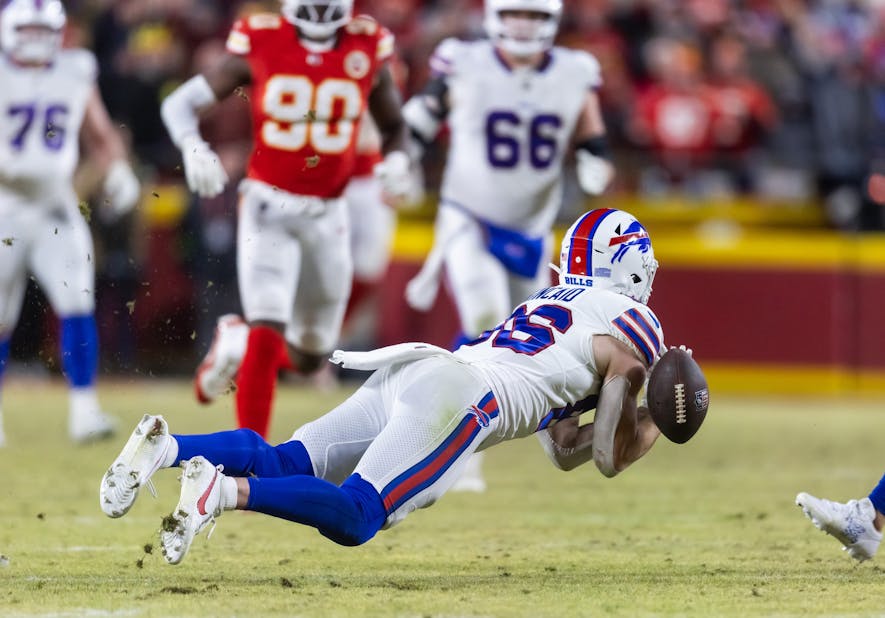The flip side of succeeding with undervalued players is failing with overvalued players. They can clog your roster and never seem to match your expectations. Avoiding them is another important key to a successful fantasy team. To point out these players, we asked our staff to identify players available in the top half of your draft who should underperform their draft position.
RELATED: See 3 Underrated Tight Ends here
Four overrated tight ends quickly gathered interest. See what our staff has to say about each player.
Overrated TE Dalton Kincaid, Buffalo
Jason Wood: Dalton Kincaid was supposed to be the next young, immediate-impact tight end to take the NFL by storm. However, his rookie season ultimately proved to be good, rather than great. He finished as TE13. That early success led much of the industry to project a 2024 breakout. Instead, Kincaid regressed, finishing as TE21 on a per-game basis.
Even more concerning, his role declined as the season wore on. He ranked as TE33 in the second half of the year. The reality is that the Bills have shown they don't trust Kincaid as a difference-maker. He's just another guy, someone who will make the occasional play when a defense blows a coverage, not someone you can count on week to week.
Ben Cummins: Dalton Kincaid missed four games and played through injuries at times last season. That is important context, but there is no way to fully excuse his massive letdown in 2024.
After Stefon Diggs was traded away, Kincaid was expected to take a significant leap in his second season without any true alpha wide receiver on the Bills. Instead, he finished third on the team in receiving yards (448) and had fewer than rookie Keon Coleman despite Coleman also missing four contests.
Dawson Knox played a significant role in the offense last year and is projected to do so once again in 2025, as he's a better blocker than Kincaid. Knox played on 50+% of the offensive snaps in 13 of 16 regular-season games and out-snapped Kincaid in all three playoff games.
Offensive coordinator Joe Brady returns for another season, and his offense spread the ball around last year. Six players saw between 25 and 50 targets in addition to Kincaid, Coleman, and Khalil Shakir's volume. Kincaid isn't good enough to register worthwhile production, essentially operating as a big receiver, and the offense he's in doesn't do him any favors since Brady and Josh Allen don't funnel targets.
Colton Dodgson: Bills pass catchers will give me some pause heading into next season. Not because this isn't a great offense with talented options. It's because of the dispersion of their targets. Khalil Shakir led the team in targets per game with 6.7. That ranked 42nd in the NFL. Further, eight players saw at least two targets per game in Buffalo last season.
For what it's worth, Dalton Kincaid was second with 5.8 targets per game with a target percentage of 29 percent. His 3.4 receptions, though, were 18th. His +0.13 EPA/target was 23rd with a catch rate over expected of -11.6 percent.
This isn't a system under Joe Brady in which one option will see a massive target share, or even an above-average target share. Given how well it worked for them last year, I wouldn't expect much of a departure from the identity.
Maurile Tremblay: Dalton Kincaid remains a fashionable breakout pick, but there are multiple reasons to steer clear in 2025. His second campaign was actually a step back: knee trouble limited him to 13 games, and he finished outside the top 20 at the position despite playing with Josh Allen.
Nothing about Buffalo's offseason suggests a sudden target spike. The Bills kept Dawson Knox because his $14.5 million cap hit makes cutting him impractical, guaranteeing continued two-tight-end rotations and siphoning valuable routes near the goal line.
Meanwhile, GM Brandon Beane flooded the receiver room with Joshua Palmer, Elijah Moore, and Curtis Samuel to join Keon Coleman and Khalil Shakir, an influx that crowds whatever middle-of-the-field volume Kincaid once feasted upon.
Joe Brady's offense already leaned on heavy personnel to bolster the ground game (both tight ends topped 40 percent snap share last year). That philosophy remains, meaning Kincaid is asked to block as often as he releases into the pattern.
Add in Allen's tendency to call his own number inside the ten, and Kincaid must achieve rare efficiency just to match last season's middling fantasy finish. That upside-dependent profile is one to fade when clearer paths to volume are available.

